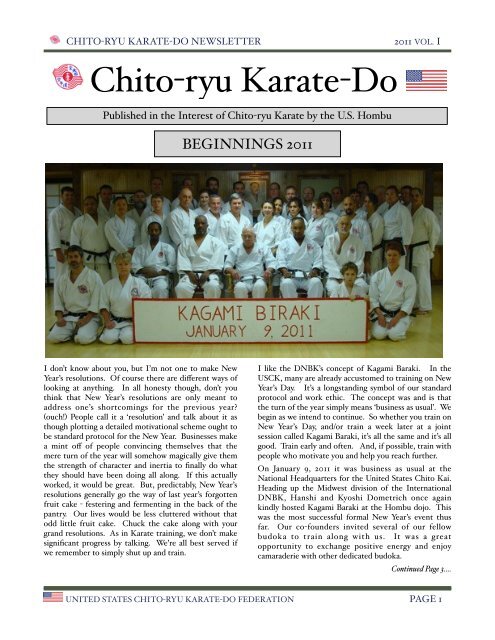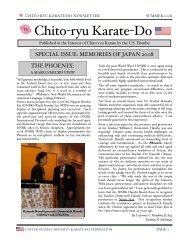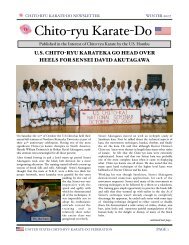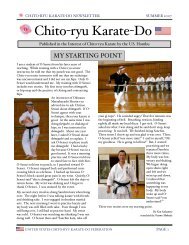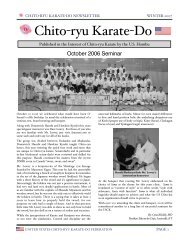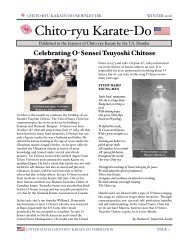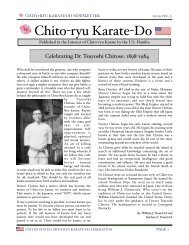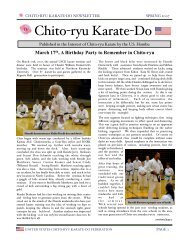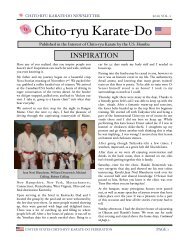Chito-ryu Karate-Do - United States Chito-ryu Karate Federation
Chito-ryu Karate-Do - United States Chito-ryu Karate Federation
Chito-ryu Karate-Do - United States Chito-ryu Karate Federation
Create successful ePaper yourself
Turn your PDF publications into a flip-book with our unique Google optimized e-Paper software.
CHITO-RYU KARATE-DO NEWSLETTER 2011 VOL. I<br />
<strong>Chito</strong>-<strong>ryu</strong> <strong>Karate</strong>-<strong>Do</strong><br />
Published in the Interest of <strong>Chito</strong>-<strong>ryu</strong> <strong>Karate</strong> by the U.S. Hombu<br />
I don’t know about you, but I’m not one to make New<br />
Year’s resolutions. Of course there are different ways of<br />
looking at anything. In all honesty though, don’t you<br />
think that New Year’s resolutions are only meant to<br />
address one’s shortcomings for the previous year?<br />
(ouch!) People call it a ‘resolution’ and talk about it as<br />
though plotting a detailed motivational scheme ought to<br />
be standard protocol for the New Year. Businesses make<br />
a mint off of people convincing themselves that the<br />
mere turn of the year will somehow magically give them<br />
the strength of character and inertia to finally do what<br />
they should have been doing all along. If this actually<br />
worked, it would be great. But, predictably, New Year’s<br />
resolutions generally go the way of last year’s forgotten<br />
fruit cake - festering and fermenting in the back of the<br />
pantry. Our lives would be less cluttered without that<br />
odd little fruit cake. Chuck the cake along with your<br />
grand resolutions. As in <strong>Karate</strong> training, we don’t make<br />
significant progress by talking. We’re all best served if<br />
we remember to simply shut up and train.<br />
BEGINNINGS 2011<br />
I like the DNBK’s concept of Kagami Baraki. In the<br />
USCK, many are already accustomed to training on New<br />
Year’s Day. It’s a longstanding symbol of our standard<br />
protocol and work ethic. The concept was and is that<br />
the turn of the year simply means ‘business as usual’. We<br />
begin as we intend to continue. So whether you train on<br />
New Year’s Day, and/or train a week later at a joint<br />
session called Kagami Baraki, it’s all the same and it’s all<br />
good. Train early and often. And, if possible, train with<br />
people who motivate you and help you reach further.<br />
On January 9, 2011 it was business as usual at the<br />
National Headquarters for the <strong>United</strong> <strong>States</strong> <strong>Chito</strong> Kai.<br />
Heading up the Midwest division of the International<br />
DNBK, Hanshi and Kyoshi <strong>Do</strong>metrich once again<br />
kindly hosted Kagami Baraki at the Hombu dojo. This<br />
was the most successful formal New Year’s event thus<br />
far. Our co-founders invited several of our fellow<br />
budoka to train along with us. It was a great<br />
opportunity to exchange positive energy and enjoy<br />
camaraderie with other dedicated budoka.<br />
Continued Page 3....<br />
UNITED STATES CHITO-RYU KARATE-DO FEDERATION PAGE 1
CHITO-RYU KARATE-DO NEWSLETTER 2011 VOL. I<br />
Editorial THE KARATE-DO STAFF<br />
The Essence of the Way<br />
In <strong>Karate</strong> there is no first attack, this idea embodies the essential spirit<br />
of karate from Okinawa. While karate is a martial art, it is defensive<br />
from beginning to end. The primary function of karate-do lies in its<br />
defensive function. All martial arts students must strive to develop and<br />
cultivate both the mind as well as the body. True karate training is to<br />
improve the practitioner's health both mentally and physically.<br />
Those who follow the way of karate (both students and instructors)<br />
should consider courtesy as the main stay of all karate training, it’s<br />
essence. With out this focus the primary reason for karate training is<br />
lost. People without courtesy are not qualified to be karate students or<br />
instructors even if they execute flawless karate technique and kata.<br />
<strong>Karate</strong> training starts and ends with a bow. This simple bow signifies<br />
the recognition of the meaning of courtesy in our everyday life.<br />
Courtesy extends to all people of all countries throughout the world.<br />
Courtesy is universal; it goes beyond language, race, sex, age and<br />
religion.<br />
All practitioner of karate-do should always demonstrate humble<br />
demeanor and gentle manners. Only the narrow-minded persons boast<br />
of their inadequate skills. <strong>Karate</strong> training has as its primary goal to<br />
create a well-balanced person of good sound mind through life long<br />
training. Those who practice karate should not stop with perfection of<br />
technique. They should dedicate their lives to seeking the true meaning<br />
of <strong>Karate</strong>-do.<br />
To master karate-do requires dedication and strenuous effort. The way<br />
of karate is fueled by the conflict within oneself and may be thought of<br />
as a life long marathon, which can only be won through self-discipline,<br />
hard training, and creative effort. The end goal of karate-do is selfperfection<br />
and must include Physical, mental and spiritual training to<br />
become one, to create art.<br />
Through karate training we can obtain the highest levels of beauty and<br />
strength. The joining of mind and body in karate is indescribably<br />
beautiful and of great spiritual value. The flow of the mind when totally<br />
absorbed in the practice of kata brings us into contact with the essence<br />
of core of one’s inter being. It is here at that moment that the spirit of<br />
karate-do is to be found- through perspiration, not discussion, actions<br />
not words karate training is seeking. There is no end to it. It is an<br />
“Endless Quest”<br />
Adapted !om the writings of Shigeru Takamiyagi<br />
Submitted by: Wi"iam J. <strong>Do</strong>metrich, Hanshi<br />
Barbara <strong>Do</strong>metrich<br />
Okusan@fuse.net<br />
Cyna Khalily, MD<br />
Cyna@Khalily.com<br />
CONTRIBUTORS<br />
Editor-in-Chief<br />
Yoseikan Hombu<br />
Covington, KY<br />
Assistant Editor<br />
Yoseikan Takanoko<br />
Louisville, KY<br />
William J. <strong>Do</strong>metrich<br />
Mina K. Ludwig<br />
Gordon Levin<br />
Reg Corbett<br />
Jesse Brown, Jr<br />
Mark Chisenhall<br />
Jen Benzinger<br />
Eric Amtmann<br />
Cyrus Khalily<br />
UNITED STATES CHITO-RYU KARATE-DO FEDERATION PAGE 2
CHITO-RYU KARATE-DO NEWSLETTER 2011 VOL. I<br />
Continued !om page 1...<br />
Apparently, by formalizing this New Year’s training, we<br />
were assured that other budoka were training on the<br />
same day as well all over the world.<br />
As always, a good time was had by all. And when I say<br />
‘all’, there were a lot of bodies on that lower deck, forty<br />
seven bodies actually. I’m pretty sure that’s against fire<br />
code. Furthermore, there was less than standing room<br />
only in the kitchen after class when we all enjoyed a<br />
delicious meal together prepared by Paul and Kathy<br />
Webster. Hanshi mentioned that next year we may need<br />
to use the <strong>Chito</strong>-kai kan in Cincinnati in order to<br />
accommodate all those motivated participants. Almost<br />
too many people to fit on the deck? That’s definitely a<br />
good way to start 2011.<br />
We trained under the direction of several welcome guest<br />
instructors: Devorah Herbst, Melvin Lewis, Sonny Kim<br />
and Jeff Thompson. As per usual, Dwight Holly was<br />
happy and energetic about training along with us as well.<br />
Of the forty seven participants, only a handful were kyu<br />
ranks and they really did an outstanding job.<br />
Appropriate to the occasion, we worked on ‘the<br />
beginning’. Advanced concepts are basic. They seldom<br />
look very difficult. So the work we did on hip motion,<br />
tenshin (body shifting), generation of power and the like<br />
is both the beginning and the end. It’s all a matter of<br />
how we move and center ourselves. Again, we see karate<br />
as a metaphor or mirror for life in general. It’s not<br />
about the fruit cake, resolutions or a convoluted, wordy<br />
path forward. It’s elemental and basic. It’s always a<br />
beginning. Find your center and move from there.<br />
By: Mina K. Ludwig<br />
Yoseikan Yoshisu<br />
UNITED STATES CHITO-RYU KARATE-DO FEDERATION PAGE 3
CHITO-RYU KARATE-DO NEWSLETTER 2011 VOL. I<br />
OKUSAN HAS MASTERY OF ZAI ? SHOCHUGEIKO 2010<br />
So I was thinking of what should be the theme for this<br />
year’s Shochugeiko (which was a really good one, in case<br />
you missed it) and our good friend Kyoshi Holley of<br />
Shotokan provided it to me out of the blue via his<br />
facebook page…you see, he posted a video clip from a<br />
cult classic early 80’s martial arts flick called “Enter the<br />
Ninja” with Franco Nero (and yes, I’ve seen it multiple<br />
times); coincidently Kyoshi posted the part in which<br />
Nero is asked by his Ninjitsu Sensei to demonstrate the<br />
9 Kuji-in for the 9 levels of ninjitsu<br />
power and there it was! The eighth level of power was<br />
“Zai” - controlling the elements of nature!<br />
It had been forecast to rain on the day of Shochugeiko<br />
this year and it actually had already been raining and<br />
thundering earlier in the morning in the Ft. Wright area.<br />
Sensei Wes Ernest (our ever-gracious host) decided to<br />
stop picking blackberries early, so it must have been<br />
serious. Within an hour of the Seminar start time<br />
though, the rain suddenly stopped, the sun came out and<br />
started drying out the grass, and the seminar proceeded<br />
without a hitch. After the post-seminar Barbeque was<br />
completed, which was delicious as always thanks to the<br />
Websters and friends, the clouds suddenly reappeared<br />
and it was raining again within the next hour. It was<br />
quite mysterious at the time, but then I remembered<br />
prior to the seminar Okusan made some vague<br />
references to the weather forecast and she said, ”It won’t<br />
rain…I forbid it”. - So now I’m looking at this video clip<br />
and I’m suddenly filled with mental images of Okusan<br />
performing some ancient secret ninjitsu kata on the field<br />
prior to anyone else arriving; complete with burning<br />
incense, some bells ringing, and maybe the earth<br />
trembling a little bit. As Hanshi said later, “She is our<br />
secret weapon.”<br />
The seminar itself was excellent with multiple distinctly<br />
different training sections provided by at least 5<br />
instructors. From Sensei Eric Ford and <strong>Do</strong>n Schmidt, we<br />
spent time covering <strong>Chito</strong>-<strong>ryu</strong> basics and waza. From<br />
Sensei Devorah Herbst and later Bill Jansak we covered<br />
the bo kata Sakugawa no kon sho and then many more<br />
<strong>Chito</strong>-<strong>ryu</strong> katas also taught Sensei Jansak and Kyoshi<br />
Hawkins. Hanshi was ever-present with his usual wisdom<br />
and sporting a spiffy new wireless mic that really helped<br />
save his voice. The review of the upper yudansha level<br />
katas was very welcome by me personally as we don’t<br />
often get a chance to work up to that level of kata at our<br />
local dojo, as we always have beginners. The afternoon<br />
ended with a surprise re-emergence of the “Gauntlet”; a<br />
training drill that I had not participated in for quite<br />
some time and it’s something that would take too long to<br />
explain here for those that have never seen it. I think<br />
that the Gauntlet may have required just a little too<br />
much group coordination for all of the non-<strong>Chito</strong>-<strong>ryu</strong><br />
participants who had never done that before. We didn’t<br />
seem to hold formation very well or for very long, but it<br />
was great to watch and be part of. I want to thank all of<br />
the <strong>Chito</strong>-kai Yudansha who gave of themselves and took<br />
on teaching the Kyu ranks, I do remember specifically<br />
seeing Sensei Mike Messinger and John Wellbrock<br />
breaking out to teach some sections…but there were<br />
many more that I didn’t see, or at least too many for me<br />
to remember or name here for fear of leaving someone<br />
out. Also, I’d like to thank Hanshi and Kyoshi Hawkins<br />
who were always there with a pearl of wisdom when<br />
there was a question, or with a nugget of technical detail<br />
at particular points in our katas. I love that stuff.<br />
All in all, it was just one more great seminar in a long line<br />
of great seminars that Hanshi and Okusan always seem<br />
to pull off against any obstacles (Mother Nature or<br />
otherwise).<br />
P.S. In case you’re wondering, the 9th and final level of<br />
Ninjitsu power is Zen - Enlightenment (as it is with<br />
many traditional Martial Arts). So for next summer’s<br />
Shochugeiko, prior to the seminar starting, I am now<br />
envisioning Okusan performing a demonstration where<br />
she levitates in mid-air, explodes into a ball of pure light<br />
and energy, and then reappears on the other end of the<br />
field with many small forest animals all lovingly gathered<br />
around her in tribute…I’m just thinking.<br />
By :Gordon Levin<br />
Yoseikan <strong>Do</strong>jo II of Orlando<br />
UNITED STATES CHITO-RYU KARATE-DO FEDERATION PAGE 4
CHITO-RYU KARATE-DO NEWSLETTER 2011 VOL. I<br />
A LOOK BEHIND THE SCENES<br />
USCK NATIONAL CLINIC, OCTOBER 2010<br />
Before we ever get to the training, a lot of work has<br />
already been completed behind the scenes. Even<br />
beyond the tedious preparations, detailed schedules,<br />
travel arrangements, venue contracts, registrations and<br />
so forth, there’s so much mind boggling “stuff ”<br />
happening, you’re better off not knowing.<br />
So of course, I’m going to tell you all about it.<br />
For those who plan to test before the National Test<br />
Board – be prepared. Pay attention to detail and turn in<br />
all of the required documents, fees, pictures, and essays<br />
in a timely manner. <strong>Do</strong> we read it? Yup. <strong>Do</strong> we look at<br />
your test score? Definitely. <strong>Do</strong>es neatness count? Duh.<br />
Someone once said that karate-do is about how you line<br />
your shoes up against the wall. Tsune, or daily habits, is<br />
how we make karate-do a part of our essence and<br />
everyday lives. Every day is a test. If you believe that,<br />
and you believe that it all begins with the smallest detail<br />
like how you arrange your shoes, testing in front of the<br />
National Test Board will not be a problem for you.<br />
Slackers beware.<br />
Having said that, everyone did well on Friday October<br />
15 th. Hanshi was happy, so everyone was happy. He was<br />
happy because every single person who tested had a<br />
great attitude. They came ready to work hard, sweat,<br />
and perform to the very best of their personal ability.<br />
There is a lot of improvement to be had, but the right<br />
attitude and work ethic will allow us to strive towards<br />
bettering ourselves on and off of the deck. However,<br />
there are some technical issues that need to be<br />
addressed across the board:<br />
No technique is executed with a ‘limb’. Whether it is a<br />
punch, kick or a block – everything generates from the<br />
tanden and (more broadly) the koshi area. While we<br />
loosely translate koshi as ‘hips’, but the area extends<br />
from the tops of the thighs to the area below the<br />
sternum. A violent, explosive ‘snap’ of this area is what<br />
sends forth the weapon, i.e. the limb. So while we saw<br />
some hip movement, please keep working on the body<br />
connection. In <strong>Chito</strong>-<strong>ryu</strong>, our waza begin and end with<br />
some movement or engagement of the hips. However,<br />
absent the body connection, practitioners are prone to<br />
displaying a mere ‘<strong>Chito</strong>se wiggle.’ A wiggle is decidedly<br />
not O-Sensei’s legacy. So there needs to be a strong<br />
emphasis on hip snap, or engagement, which supports<br />
the waza. The more advanced you become, the smaller<br />
and more subtle the movement. Ultimately we are<br />
striving towards internal power, but we ain’t there yet so<br />
for now let’s see the right kind of movement.<br />
At the clinic, Sensei Tsuruoka admonished against ‘right<br />
angles’. If you are ever told that your technique looks<br />
‘boxy’, this is likely the right angle phenomena. For<br />
example, a front kick in the fully extended position - the<br />
hips should not be square. The side with which you are<br />
kicking should be extended beyond the center line. This<br />
principal can be applied to all kicks, but the opposite<br />
problem must be avoided – don’t overcommit the hips<br />
prior to the point of impact or focus. We saw some<br />
mawashi gerri where the kicking knee and hip had<br />
a l r e a d y<br />
crossed the<br />
center line of<br />
the body<br />
before the<br />
foot e ven<br />
t h o u g h t<br />
about getting<br />
to the party.<br />
Hips start<br />
and end the<br />
technique.<br />
Also with<br />
kicks, the<br />
knee must be<br />
raised high<br />
and must<br />
return high.<br />
Only by utilizing the same trajectory to and from the<br />
target can one hope to achieve optimal snap. Snap a<br />
towel out and return slowly or drop the angle of the<br />
return pull, and that towel simply will not snap, crackle,<br />
pop. Practice your kicks with the proper foot position<br />
and with some ‘hang time’ once back to the return<br />
position.<br />
By: Mina K. Ludwig<br />
Yoseikan Yoshisu<br />
UNITED STATES CHITO-RYU KARATE-DO FEDERATION PAGE 5
CHITO-RYU KARATE-DO NEWSLETTER 2011 VOL. I<br />
AUDRA STATE PARK 2010<br />
I had heard all the rumors and I had to find out for<br />
myself. Yes, Audra State Park is as beautiful as they say it<br />
is, truly a small slice of paradise hidden away in the<br />
foothills of West Virginia. No bugs and no rain appear to<br />
be the on going thing also.(it didn’t rain until Sunday<br />
morning) I couldn’t believe not one mosquito bite, it<br />
must be as you pass under the covered bridge the<br />
mosquitoes are not allowed in.<br />
I would like to say hi to the friends I had made and the<br />
ones I will make in the future. <strong>Karate</strong>ka from the<br />
Hombu, Yoseikan Yoshisu, Yoseikan Bridgeport,<br />
Yoseikan Charlottesville, Yoseikan Fort Bragg and<br />
Yoseikan Orlando participated and we all had a<br />
wonderful time.<br />
The event was kicked off with a Friday night pasta<br />
dinner provided by our hosts Sensei Drummond and<br />
Sensei Messinger.<br />
The next day was the day I was waiting for, the clinic.<br />
After bowing in, the clinic was dedicated to Sensei Ash,<br />
to whom on several occasions I had the pleasure to be<br />
partnered up, he will be missed.<br />
After a warm up and basics, kata was next on the agenda.<br />
Let me tell you kata on a hill is murder on the legs, but I<br />
fought my way through it. Next to happen was one of<br />
the memorable highlights of my trip. If you haven’t been<br />
on the receiving end of Hanshi’s technique you have no<br />
idea what you are missing. Picked out of the crowd, I<br />
was told to choke him. So I attempted to squeeze, that<br />
wasn’t good enough he wanted tighter and with a little<br />
grit in his smile and a twinkle in his eye, “tighter big<br />
boy!” the next thing I know I was having the inside of<br />
my breastbone massaged. Two fingers jammed into my<br />
Trachea with a downward force landed me straight on<br />
my back and getting back to my feet I volunteered again.<br />
The whole day<br />
went by so fast that<br />
it ended just like<br />
that.<br />
The weekend was<br />
closed with yet<br />
a gain another<br />
dinner from our<br />
hosts. Which by<br />
the way I would<br />
like to say thank<br />
you, that includes<br />
everyone involved<br />
for helping make<br />
this event happen.<br />
The learning didn’t<br />
stop there for me, I<br />
received some top<br />
notch knot tying instruction from Sensei Poe and also he<br />
pointed out the difference between an Indian fire and a<br />
white mans fire. Good looking out Sensei Petty, I might<br />
never have known why the Banks’ dog didn’t like me<br />
until you said something.<br />
Sunday morning had come and we had to break camp, I<br />
knew the weekend was over. Back out under the covered<br />
bridge I went. On the way home I stopped in Clarksburg<br />
to see the dedication sign for Hanshi and also saved a<br />
dog that was running on the highway. So all and all I had<br />
an awesome weekend. Thanks again for the experience.<br />
Training With Intensity, But Consistently<br />
By: Reg Corbett<br />
Hombu <strong>Do</strong>jo<br />
THE WILL TO PREPARE!<br />
Over the years, most of us realize we just cannot learn<br />
karate on our own. <strong>Karate</strong> has traditions and<br />
techniques; traditions handed down by those who have<br />
gone before and techniques that must be carefully<br />
refined. It is a long, slow process of hard work, making<br />
mistakes and repetitive learning.<br />
In our karate world of sensei, sempai, and kohai, we<br />
know where students get their training and the will to<br />
prepare takes place in the dojo. <strong>Karate</strong> is not just about<br />
attaining rank and winning championships. It’s about<br />
the will to prepare, the will to practice techniques, and<br />
the will to train hard and long. It’s about the will to do<br />
your best. Anyone who wants to learn karate in the dojo<br />
spends years studying techniques, principles of<br />
kinesiology, anatomy, and the history and philosophy of<br />
UNITED STATES CHITO-RYU KARATE-DO FEDERATION PAGE 6
CHITO-RYU KARATE-DO NEWSLETTER 2009 VOL. 2<br />
karate in general. However, the will to train hard and<br />
long is the key to development and success.<br />
The art of karate-do has long been considered a way of<br />
life, and we now see the growth of competition karate<br />
and the emphasis on training for sport. Sport karate has<br />
seriously eroded the tradition and the spirit of Budo<br />
karate with the will to prepare. Thinking only about<br />
how to win is moving in the wrong direction. That is<br />
why we still have traditional martial art dojos to preserve<br />
and maintain the traditional karate of Okinawa and<br />
Japan along with the will for serious training.<br />
When I began my karate training in <strong>Chito</strong>-<strong>ryu</strong>, June of<br />
1971, under the instruction of the late James Merolillo,<br />
Sensei, my life’s work on the dojo floor has been a<br />
continuation of learning, studying and refining<br />
techniques. During my 39 years of training, I have had<br />
the opportunity to explore karate concepts and ideas<br />
about training. I sought to always stress the practical<br />
applications of kihon, kata, and bunkai and not the<br />
superficial and sterile form of sport karate, which has<br />
replaced the old tradition of budshido with a set of<br />
prearranged gymnastic routines designed to display the<br />
athletic and gymnastic skills of the performers.<br />
The concept and idea of traditional karate is like<br />
sculpting or painting, however, the only thing is that we<br />
do not work with a canvas and we don’t work with clay,<br />
we work with ourselves. The will to prepare begins when<br />
we start to train and we mold ourselves. Thus, we are<br />
creating, hopefully, what will become a work of art. The<br />
more we polish it, chisel it, shape it, put into it, the more<br />
it begins to take on certain features. The caliper of<br />
technical skills becomes sharper together with the<br />
development of speed, thereby balance and power is<br />
increased. People who study traditional karate spend a<br />
lot of time creating something that really begins to take<br />
a specific form and those who are successful, end up<br />
molding their particular piece of art.<br />
<strong>Karate</strong>ka’s of the art who are evolving, chiseling, and<br />
polishing themselves to kick, punch and block correctly<br />
work hard and constant. The standards in traditional<br />
karate are high and you will need stamina, endurance and<br />
especially the will to prepare if you are to succeed. If<br />
traditional karate is going to be a major part of your life,<br />
a discipline where you can discover your ability as an<br />
artist, a sculptor of kihon, kata, and bunkai techniques in<br />
concert with the development of character and the total<br />
self-motivation to pursue the spirit of Bushido, then the<br />
will to prepare begins with a life long commitment to<br />
karate training. Undertaking it with much mental<br />
readiness and the will to prepare for serious and hard and<br />
constant training begins right now!<br />
By: Jesse Brown, Jr. Yoseikan Rochester<br />
Laura Stith Deck, PhD Shihan<br />
Vital Statistics: Married to Steve Deck for 14 years<br />
Children: Mitch 11 and Nick 8<br />
Education: Walnut Hills High School Cincinnati,<br />
BA (Psychology) from Indiana University 1989<br />
MA (Clinical Psychology) from University of Cincinnati<br />
1992<br />
Ph.D. (Clinical Psychology, specializing in children and<br />
adolescents) from University of Cincinnati 1996<br />
Current employment:<br />
Chief Clinical Officer at Child Focus, Inc.<br />
Co-leader of Clermont County Crisis Response Team<br />
Recently hired to conduct PTSD and other MH<br />
evaluations on veterans<br />
Begin <strong>Chito</strong>-Ryu: 1983<br />
INSTRUCTOR PROFILE<br />
Current rank and Title: Yon Dan Shihan<br />
Extra Curricular activities: Volunteering on boards/<br />
committees.<br />
Spending time with immediate/extended family and<br />
friends at lake house on Norris Lake, Tennessee.<br />
On her night stand: A light and an alarm clock that don't<br />
work b/c I don't have an outlet near mynightstand at my<br />
new home (anyone know a good electrician?)<br />
Kempo <strong>Karate</strong>-do by Dr. <strong>Chito</strong>se - My eight year old son<br />
just saw this 2 days ago and asked me if someday I would<br />
read it to him.<br />
UNITED STATES CHITO-RYU KARATE-DO FEDERATION" PAGE 7
CHITO-RYU KARATE-DO NEWSLETTER 2011 VOL. I<br />
A WEEKEND TO REMEMBER<br />
I have to admit that I was more than a little nervous<br />
about testing for my Ik -Kyu this October in front of the<br />
National Test Board. After all, I had never tested<br />
anywhere except my own dojo in front of my own<br />
teacher and fellow students, and that was nerve racking<br />
enough! I walked into the Hombu on Friday evening<br />
reminding myself that all I could do was my best and<br />
hope that it was good enough. I was welcomed warmly<br />
by everyone there, which, along with a lot of praying,<br />
helped to ease my nerves.<br />
I didn’t really know the other students testing, though I<br />
New Ik kyu: Author fourth from left<br />
had seen most of them before at other clinics. By the<br />
end of the night, I felt a connection to all of them. The<br />
test went by in a blur. The deck drills were not too<br />
complex (to my relief), but they were numerous and<br />
speedy and definitely got us warmed up. Then it was on<br />
to kata, in small groups and individual. Lastly was<br />
Sanbon kumite and Ippon jiyu kumite. Then…the wait.<br />
Sensei John Wellbrock came up to the upper deck where<br />
we were all waiting and informed us that the board had<br />
decided that those of us who were on the fence would<br />
have to spar each other. The winner would pass and the<br />
loser would be back in March to retest. You should have<br />
seen the looks on our faces before he told us he was just<br />
kidding. I can laugh about it now. He really had us<br />
going there for a minute!<br />
Shortly, the test board had the results and had some<br />
helpful critiques as well as praises for each student. No<br />
one was perfect, but that’s not really the point of testing.<br />
Testing is a time to show what you can do and to learn<br />
the areas where you need to practice more and improve.<br />
In the end, 13 people tested and 13 people passed and all<br />
were given some areas to work on. It was a great<br />
experience.<br />
After a long, emotional night at the Hombu, it was time<br />
for the annual October clinic at the Drawbridge Hotel.<br />
We started the 4&1/2 hour long clinic with a quick warm<br />
up and then Hanshi <strong>Do</strong>metrich led us through an hour<br />
of <strong>Chito</strong> Ryu basics.<br />
It’s always good to go back to basics and polish up on<br />
things that we assume we are doing correctly, but maybe<br />
have become sloppy or rusty with. Then our guest for<br />
the weekend, Sensei David Tsuruoka from Canada, took<br />
us through the next 3 hours. He emphasized the<br />
importance of hip snap and speed. He asked us not to<br />
“think” about technique, as this can cause you to slow<br />
down. He reminded us that speed and power come from<br />
the tanden and that the foot, fist, elbow, etc. are only a<br />
vehicle with which to transfer the energy to the<br />
opponent. We worked on many bunkai and applications<br />
to reinforce his teachings. I was exhausted by the end,<br />
but amazed that 4 & ½ hours had gone so quickly.<br />
There was just enough time to rush home, shower,<br />
change and make it back to the Drawbridge for the<br />
annual October awards banquet. It was great to see so<br />
many faces, some new and some familiar, from dojos<br />
throughout the states. I had the pleasure of sitting next<br />
to and conversing with Sensei Jesse Brown from<br />
Rochester, New York who gave a beautiful opening<br />
prayer and closing benediction. The food and<br />
conversation were wonderful and it was inspiring to see<br />
everyone who received awards and promotions. Sensei<br />
John Wellbrock did a fantastic job summing up the<br />
highlights of the past year, complete with costume<br />
changes- very impressive! The best part was when he<br />
presented Sensei Mina Ludwig with fabric freshener and<br />
a broom for the next time she made her infamous<br />
“witches brew”!<br />
After the banquet, it was nice to unwind around the<br />
pool and to see Hanshi and Okusan finally get to relax.<br />
Tsuruoka Sensei was a delight to talk to and after a<br />
couple glasses of liquid courage, I finally got the nerve to<br />
get my passport signed by many if the sempai who have<br />
inspired me these last 4 years. I want to thank everyone<br />
for being so gracious and a special thank you to Hanshi<br />
and Okusan and all those behind the scenes who made<br />
this weekend a success and one that I will never forget.<br />
By: Jen Benzinger<br />
Yoseikan Anderson<br />
UNITED STATES CHITO-RYU KARATE-DO FEDERATION PAGE 8
CHITO-RYU KARATE-DO NEWSLETTER 2011 VOL. I<br />
ONAGA YOSHIMITSU & COMPANY VISITS<br />
YOSEIKAN OF NAPOLEON<br />
On November 20, 2010 Onaga Yoshimitsu sensei, joined<br />
by several students from Michigan, New York, Okinawa<br />
and Canada visited Yoseikan of Napoleon by way of<br />
Herbst Sensei. In addition, Beshears Kyoshi and Khalily<br />
Renshi were also in attendance. Hanshi and Okusan<br />
watched from the sidelines as honored guests for a<br />
majority of the class.<br />
Devorah <strong>Do</strong>metrich-Herbst Sensei hosted Onaga<br />
Sensei’s visit from Okinawa for a week long training<br />
session that took place at her farm in Dry Ridge, KY.<br />
Herbst sensei began training with Onaga 10 years ago as<br />
a result of one of her many visits to Okinawa. As a<br />
student of Okinawan kobudo, she has bridged the gap<br />
for many students to learn martial arts, not just kobudo<br />
but also karate, from a variety of teachers and is<br />
instrumental in bringing many different styles together.<br />
Onaga Sensei resides in Okinawa, Naha city where he<br />
trains in Kobayashi Shorin-<strong>ryu</strong>, but also trains and<br />
teaches Okinawan “Ti.” Ti is considered the precursor<br />
to modern day karate. Onaga Sensei trains the “Dai<br />
Sensei” on Okinawa, the heads of other styles schools, in<br />
Okinawa in Ti. So it was a great honor to get to host him<br />
for an evening of learning.<br />
The concepts of Ti are quite similar to the modern day<br />
concepts of karate. However, we as <strong>Chito</strong>-<strong>ryu</strong><br />
practitioners are lucky in that we have an advantage. Our<br />
training by way of Hanshi and O-Sensei has maintained<br />
its traditional roots and it proved itself on the deck<br />
when training with Onaga Sensei. Although Ti is<br />
considered an art to itself, separate from karate, it is still<br />
karate, just not necessarily the modern version most<br />
people train or teach. We always have been a little<br />
different…and it came in handy. Our well rounded style<br />
with little focus on tournament style karate fit perfectly<br />
into the lesson plan, much to Onaga Sensei’s surprise.<br />
Ti focuses on the “How to” of karate techniques. For<br />
example we started with the “How to” step. Onaga<br />
Sensei breaks down the actions into bullet points so it is<br />
easy to follow. He discussed the 3 points on the feet<br />
which are used for controlling the stepping action, which<br />
we have trained. He discussed “tenshin,” not the kata,<br />
but the action, which is directional stepping. While we<br />
typically think of tenshin happo, (8 directions stepping),<br />
Onaga has a few extra turns. We then moved into the<br />
positioning and movement of the hips for proper and<br />
unadulterated or unimpeded movement. That of course<br />
took the discussion to hip movement and interaction<br />
with the feet and body. We also trained a segment as if<br />
he was a fly on the wall at our national event in October<br />
when Tsuruoka Sensei was teaching the proper punching<br />
exercises and how to extend the arm in the shoulder<br />
socket.<br />
In a nutshell, the underlying theme was relaxation and<br />
correct and decisive movements. Onaga Sensei was quick<br />
to point out the relationship of our body and our<br />
movements with the existence and flow of water. It is an<br />
analogy used repeatedly in martial arts, but it is another<br />
to actually implement it in your training. Very often we<br />
“try” to do techniques instead of letting them flow. We<br />
muscle a punch or a block when it is only counterproductive<br />
to our effectiveness. The water flow also goes<br />
much deeper, but there isn’t enough time or space to<br />
begin that discussion. Suffice it to say we can all relax<br />
more and let the technique flow.<br />
After the training we were invited back to Herbst<br />
sensei’s house for a Sayonara party where we ate and<br />
drank while listening to various members of the group<br />
take turns playing the guitar and singing. In addition, we<br />
were surprised by an iai demo in Herbst Sensei’s living<br />
room by Onaga Sensei’s companion, Arakaki Sensei. It<br />
was very surprising because he was so quite the whole<br />
day you wouldn’t even notice or miss him, but as it turns<br />
out he is considered the premier iaido ka on the island of<br />
Okinawa.<br />
As I said earlier it was not much new, but a different<br />
explanation of basically the same material. In large part<br />
it was an affirmation that we are on the traditional path.<br />
While some of it was for more advanced belts the<br />
message was still the same…train smarter, not harder. It<br />
is very clear that Onaga Sensei has put a lot of effort and<br />
energy into his art and it is always nice to be in the<br />
presence of someone who is passionate about the subject<br />
they are presenting and teaching.<br />
By: Mark Chisenha"<br />
Yoseikan of Napoleon, KY<br />
UNITED STATES CHITO-RYU KARATE-DO FEDERATION PAGE 9
CHITO-RYU KARATE-DO NEWSLETTER 2011 VOL. I<br />
BECAUSE SPIRIT FLOWS LIKE WATER AND<br />
TIME IS LIKE A RIVER<br />
This year makes 10 years since Shihan Art Rott’s passing.<br />
Close to Shihan’s Art’s old dojo is a park he loved. The<br />
beauty of this park is a pure and natural wonder and also<br />
is our theme for the clinic.<br />
Hanshi <strong>Do</strong>metrich started the Winter Getaway’s in the<br />
70’s and the tradition is still going strong!<br />
The February 12, “Winter Getaway 2011” Clinic started<br />
out with a ¼ mi.walk to the spring head. Millions of<br />
gallons of fresh water flowing straight from the ground.<br />
Where Aquifer meets ground level emerging after up to<br />
40 years underground. Springing forth making the “Rock<br />
Springs Run”<br />
The 5 elements represented.<br />
I compared the many Rocks to our foundation in <strong>Karate</strong><br />
and the natural element “earth” which relates to Stance.<br />
Upon return to the training area I spoke of Mushin and<br />
the empty place created by pooling Water and how well it<br />
reflects and depicts its surroundings. Water is often<br />
compared to life and energy springing forth seeking out its<br />
boundaries and discovering the world and I compared that<br />
to the <strong>Karate</strong>ka who needs to understand all things big<br />
and small so they wont be upset in conflict. The<br />
knowledge of the aquifer (underworld) that we cannot see<br />
reminds us of our connection to our own energy and<br />
things we cannot see. The water, perfectly clean and pure,<br />
like the spirit needed to find truth and necessary for good<br />
development. Flowing water is efficient and productive<br />
which all correlates to Strategy, Ease, and confidence. I<br />
mentioned the wind that represents our style. Kyoshi<br />
Hawkins mentioned the sun which is the element Fire and<br />
correlates to the fight and use of forceful energy.<br />
The Japanese Torii gate emerged as our symbol for this<br />
event. Signifying a sacred place and a metaphor for our<br />
inner self. Kyoshi Hawkins led us through a training that<br />
was rigorous and spirit flowed like water. The training<br />
session culminated with demonstrations by Go dans and<br />
above and was truly a joy. Kyoshi Hawkins was awarded a<br />
miniature Torii gate as a faithful supporter of the Winter<br />
Getaway<br />
HIGH SCHOOL DEMO<br />
By: James Acampora<br />
Yoseikan of Orlando II<br />
From left to right Mike Shaefer, Mrs. Burns, Shawna<br />
Lingo and Eric Ford<br />
On December 15, 2010, U.S. <strong>Chito</strong>-kai representatives<br />
presented a practical self defense class for two Highlands<br />
High School classes. The basic ideas conveyed in the<br />
class were to avoid potential dangerous situations, be<br />
prepared for bad situations, and to become aware of your<br />
actions. Several basics were taught, such as knee and<br />
elbow attacks practiced on a bag and the standard arm<br />
wrist escape. We enjoyed knowing the group walked<br />
away with a few practical self defensive moves and<br />
suggestions to help them make better choices in life. We<br />
would like to thank Mrs. Burns for inviting us and the<br />
High School permitting the class during normal school<br />
hours.<br />
Thank you again for the opportunity.<br />
UNITED STATES CHITO-RYU KARATE-DO FEDERATION PAGE 10
CHITO-RYU KARATE-DO NEWSLETTER 2011 VOL. I<br />
KETSUI O SURU - MAKE UP YOUR MIND<br />
Charlottesville Yoseikan held it's second Kangeiko on<br />
January 28-29, 2011, concurrent with Kangeiko at the<br />
Honbu. Our theme this year was "Ketsui O Suru", or<br />
"Make Up Your Mind." During Friday evening's sake<br />
ceremony, Sensei Gage, Sensei Monge, and Sensei Rike<br />
encouraged us to consider the meaning of this phrase<br />
with respect to our karate training and development as<br />
individuals. I am certain each karateka participant<br />
responded to the Kangeiko challenge in a unique and<br />
personal way, but I will share some of my reflections.As a<br />
newcomer to martial arts, a Hachi kyu (Yellow Belt) with<br />
only a few months experience at our dojo, I expected to<br />
be somewhat overwhelmed by the complexity of the<br />
training with my quite limited skills. I set a few simple<br />
goals for myself - attempt to fully engage the training<br />
mentally and physically, remain relaxed, and above all<br />
don't become frustrated or discouraged if I found myself<br />
in way over my head. After all, how could we possibly<br />
train for 6 hours without the bulk of the training being<br />
very new?<br />
I remember the first hour quite distinctly, with Sensei<br />
Keese leading us through a familiar warmup, kihon, and<br />
beginner kata familiar to me, Juni Waza, Taikyoku Ichi,<br />
San ju ko, and Taikyoku Ni. At this point, Sensei Keese<br />
asked Sensei Gage if lower ranking karateka should step<br />
to the side of the deck during more advanced kata.<br />
Sensei Gage's response was something to the effect of,<br />
"no, they will just have to do their best to keep up." Here<br />
was the deep water I knew was over the horizon, and yet<br />
it is also when the magic of Kangeiko began to reveal<br />
itself.<br />
The most popular conception of what followed may be<br />
"getting in the zone," or "flow," a state of mind during<br />
athletic endeavors when one's body takes over, a state of<br />
unwilled concentration. Had this been a typical training<br />
session focused on the perfection of technique, I have no<br />
doubt that my performance would have inspired a well<br />
deserved continuous stream of corrections - bend your<br />
knees, get low, don't lean back, level your hips, rotate your<br />
hips, don't scoop your punch, your heel is popping up,<br />
which stance is THAT?, your targeting is off, chin up,<br />
eyes forward...<br />
However, that is not Kangeiko. Kangeiko is about testing<br />
your endurance, and endurance is letting go and letting<br />
the training happen. That can be quite difficult at all<br />
levels of proficiency. The natural inclination when<br />
training is for your thoughtful brain to take over and<br />
direct your body how to move. But the moment you<br />
TRY to get in the zone, you have lost it. The flow must<br />
come to you. At the seashore, you don't ride the wave,<br />
the wave carries you.<br />
And that is not only Kangeiko, but also <strong>Chito</strong>-<strong>ryu</strong> <strong>Karate</strong>do,<br />
at least to this karateka. You make up your mind to<br />
be carried along by the 'esprit de corps', and allow your<br />
training to be a positive force in your life.<br />
So go ahead, let that wave carry you.<br />
By: Eric Amtmann<br />
Yoseikan Charlottesvi"e<br />
UNITED STATES CHITO-RYU KARATE-DO FEDERATION PAGE 11
CHITO-RYU KARATE-DO NEWSLETTER 2011 VOL. I<br />
KANGEIKO 2011<br />
I started my <strong>Karate</strong> training when I was 5 years old at<br />
Yoseikan II Cincinnati. Ever since then I have wanted to<br />
participate in every national event that I could. That<br />
included many March and October clinics, Shochugeigo,<br />
Audra WV and Florida Winter getaway. But I always<br />
wanted to go to Kangeiko the most. I had heard stories<br />
about it for my whole life: sleeping on the hombu floor,<br />
1000’s of punches and kicks, fogged up mirrors, and<br />
running barefoot in the snow.<br />
But Kangeiko has always been just out of reach - the<br />
requirements for participating are a minimum of green<br />
belt and 16 years old. I was always too young, but this<br />
time, they finally let me in. I’m technically still to young<br />
to participate but I got a special dispensation to<br />
participate at 14 - I guess after 9 years they got tired of<br />
me asking.<br />
When I first arrived at the Hombu dojo, I put my sleeping<br />
bag in what was apparently the worst and coldest spot on<br />
the deck to sleep, but I kept it there anyway to have the<br />
full Kangeiko experience of sleeping in the cold. Right<br />
before the lights went off, Sensei Jansak spoke to us about<br />
the procedures that we were to go through in the<br />
morning, and he told me that we weren't allowed to know<br />
what time it was, which seemed like it would be<br />
interesting. When I woke up to the sound of what seemed<br />
to be some sort of gong, I looked around and realized<br />
where I was and got really excited. I got up and put my<br />
sleeping bag on the small deck and went into the locker<br />
room which had a very interesting atmosphere because<br />
there were a lot of people but nobody said a word. When I<br />
got on the deck I was so happy to finally be at Kangeiko.<br />
Bowing in we went through about a ten minute seiza in<br />
which I may or may not have fell asleep. Not knowing<br />
what time it is bothered me the whole time. I heard that<br />
you can smell the food cooking when the end was near,<br />
but that never happened. I peered out the window every<br />
now and then and when I saw it starting to get a little bit<br />
brighter outside I started top guess what time it was. My<br />
favorite part of the whole thing was running, because<br />
thats what Kangeiko is most known for and its the first<br />
thing that I would think of whenever I think about<br />
Kangeiko. To finally have a chance to participate in this<br />
tradition and and make it through felt like a great<br />
accomplishment. I’m excited to go back next year with<br />
Chihsenhall Shihan.<br />
By: Cyrus Khalily<br />
Yoseikan Takanoko<br />
THE UNITED STATES<br />
CHITO-RYU KARATE-DO<br />
FEDERATION<br />
22 MARTIN STREET<br />
COVINGTON, KY 41011<br />
859-291-7232<br />
WWW.CHITO-RYU.COM<br />
UNITED STATES CHITO-RYU KARATE-DO FEDERATION PAGE 12


